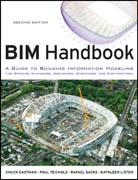
BIM handbook: a guide to building information modeling for owners, managers, designers, engineers and contractors
Eastman, Chuck
Teicholz, Paul
Sacks, Rafael
INDICE: Foreword. Preface. Chapter 1. BIM Handbook Introduction. 1. 0 Executive Summary. 1.1 Introduction. 1.2 The Current AEC Business Model. 1.3 Documented Inefficiencies of Traditional Approaches. 1.4 BIM: New Tools and New Processes. 1.5 What Is Not BIM Technology. 1.6 What Are the Benefits of BIM? What Problems Does It Address? 1.7 What Challenges Can Be Expected? 1.8 Future of Designing and Building with BIM (Chapter 8). 1.9 Case Studies (Chapter 9). Chapter One Discussion Questions. Chapter 2. BIM Design Tools and Parametric Modeling. 2.0 Executive Summary. 2.1 The Evolution to Object-based Parametric Modeling. 2.2 Parametric Modeling of Buildings. 2.3 Beyond Parametric Shapes. 2.4 BIM Environments, Platforms and Tools. 2.5 Overview of the Major BIM Design Platforms. 2.6 BIM platforms. 2.7 Lightweight Modeling Applications. 2.8 Conclusion. Chapter 2. Discussion Questions. References. Chapter 3. Interoperability. 3.0 Executive Summary. 3.1 Introduction. 3.2 Different Kinds of Exchange Formats. 3.3 Background of Product Data Models. 3.4 Other Efforts Supporting Standardization. 3.5 The Evolution from File-based Exchange to Building Model Repositories. 3.7 Summary. Chapter 3 Discussion Questions. Chapter 4. BIM for Ownersand Facility Managers. 4.0Executive Summary. 4.1 Introduction: Why Owners Should Care About BIM. 4.2 BIM Application Areas for Owners. 4.5 BIM Tool Guide for Owners. 4.6 An Owner and Facility Managers Building Model. 4.7 Leading the BIM Implementation on a Project. 4.8 Barriers to Implementing BIM: Risks and Common Myths. 4.9 Guidelines and Issues for Owners to Consider When Adopting BIM. Chapter 4 Discussion Questions. References. Chapter 5. BIM for Architects and Engineers. 5.0Executive summary. 5.1 Introduction. 5.2 Scope of Design Services. 5.3 BIM Use in Design Processes. 5.5 Considerations in Adoption for Design Practice. 5.6 New and Changed Staffing within Design Firms. Chapter 5 Discussion Questions. References. Chapter 6. BIM for the Construction Industry. 6.0Executive Summary. 6.1 Introduction. 6.2 Types of Construction Firms. 6.3 Information Contractors Want from BIM. 6.4 Processes to Develop a Contractor Building Information Model. 6.5 Reduction of Design Errors Using Clash Detection. 6.6 Quantity Takeoff and Cost Estimating. 6.7 Construction Analysis and Planning. 6.8 Integration with Cost and Schedule Control and Other Management Functions. 6.9 Use for Offsite Fabrication. 6.10 Use of BIM Onsite: Verification, Guidance, and Tracking of Construction Activities. 6.11 Synergies of BIM and LeanConstruction. 6.12 Implications for Contract and Organizational Changes. 6.12BIM Implementation. Chapter 6 Discussion Questions. References. Chapter 7. BIM for Subcontractors and Fabricators. 7.0Executive Summary. 7.1 Introduction. 7.2 Types of Subcontractors and Fabricators. 7.3 Th
- ISBN: 978-0-470-54137-1
- Editorial: John Wiley & Sons
- Encuadernacion: Cartoné
- Páginas: 552
- Fecha Publicación: 30/03/2011
- Nº Volúmenes: 1
- Idioma: Inglés
